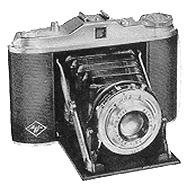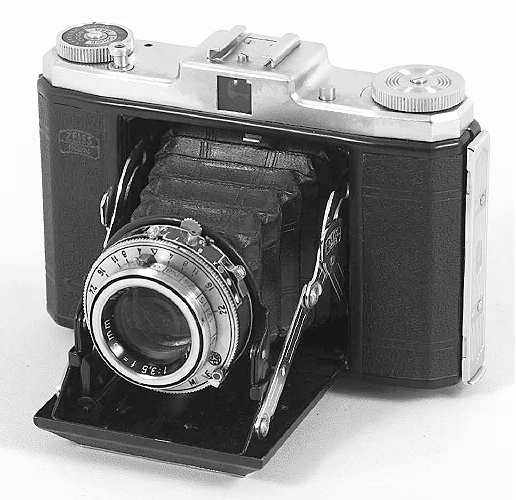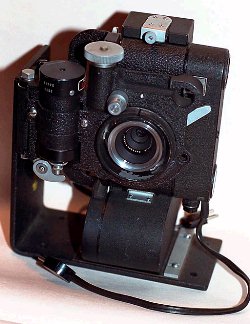The Importance of Radar Photography
In 1956, during Cyclone Agnes, Tom Sleath and Fred Soutter mounted Tom's camera
on a magnetron crate sitting on a chair and took photographs of the Townsville
277 PPI until the power failed. Fred processed the film and made the enlargements
of these the first Australian Radar Cyclone Photos.
This led to the conclusion "The radar station must be equipped for the photographing
of the PPI at least, and the photos should be taken at intervals whenever a
tropical cyclone centre is within 250 miles."(1)
Thus cameras were issued to radar stations for archiving purposes. Photos were
often taken across the radar room over the heads of the observers. In later
years the photos were transmitted by K470P Radarfax to
send them to forecasting centres.
PPI Cameras
Cameras used on the 277F radar.
 |
Agfa Isolette
F4.5 camera The Agfa Isolette series of folder cameras were made from the late 1930s through to 1960. The pre-war Agfa Isolette cameras featured a dual 6x6cm and 6x4.5cm format. Those made after the war and used by the Bureau were single 6x6cm format cameras using 120 rollfilm. Either this camera or the Zeiss Nettar were supplied to the tropical cyclone network stations (Darwin, Gladstone, Brisbane Airport, Townsville & Mackay) along with a 9 inch cable release.(2) |
| Isolette camera | |
 |
The Zeiss Nettar The Zeiss Nettar line of folding cameras was a less expensive series of cameras manufactured from 1934 until around 1958. It was a very compact camera for being medium format and quite straightforward to use. They were marketed in England as Nettar cameras. All models used 120 film, different models took different format exposures. Some took 16 exposures of 6x4.5cm whilst others took eight 6cm x 9cm exposures. Which model the Bureau used is unclear. Though they were fitted with far from the best shutters and lenses, they were more than adequate to the task of radar photography. |
| Zeiss Nettar camera | |
 |
Berning Robot
Recorder 24M camera
This camera was supplied with TR & NR spools. It used 35mm film but the frames were only 24mm x 24mm giving 50 shots to the standard 36 exposure film.. The Robot 24m camera could be electrically triggered where the others used a cable release. |
| Robot Recorder
24M camera Picture : Richard Schooler schooler@incert.com |
|
PPIs for Photography
Separate PPIs were installed specifically for photographic purposes. This ensured
that there was no interruption to observational practice as the extra PPI could
be left on the one range setting whilst the other PPI would be used by the observing
staff as necessary.
WF44 stations with PPIs dedicated for radar photography
Installed at WSO at Mascot - TAST station
Installed at Laverton (unsureof this ??)
Installed at Eagle farm in 1970
First in Radio Aids building then moved to the Weather Service Office. This
was possible with ease as a linking plug at the back of the conventional PPI
allowed an extra PPI to be connected at remote ends of split WF44 systems.
During the 1970s the cameras were controlled by a Radar
Camera Timer unit, which could initiate an exposure at a selected interval
but still allowed the camera to be operated manually if desired.
References
(1) (Radar Observations of a Tropical
Cyclone at Townsville, Queensland - Brann, Hennessy and Ryan -Proceedings of
the Tropical Cyclone Symposium, Brisbane December 1956)
(2 ) Equipment establishment Table T46
for Radar type 277F (1974)